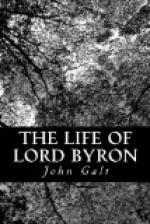Ay—we but hear
Of the survivors’ toil in their new lands,
Their numbers and success; but who can number
The hearts which broke in silence of that parting,
Or after their departure; of that malady {291a}
Which calls up green and native fields to view
From the rough deep with such identity
To the poor exile’s fever’d eye, that
he
Can scarcely be restrained from treading them?
That melody {291b} which out of tones and tunes
Collects such pastime for the ling’ring sorrow
Of the sad mountaineer, when far away
From his snow-canopy of cliffs and clouds,
That he feeds on the sweet but poisonous thought
And dies.—You call this weakness!
It is strength,
I say—the parent of all honest feeling:
He who loves not his country can love nothing.
MARINA
Obey her then, ’tis she that puts thee forth.
JACOPO FOSCARI
Ay, there it is. ’Tis like a mother’s
curse
Upon my soul—the mark is set upon me.
The exiles you speak of went forth by nations;
Their hands upheld each other by the way;
Their tents were pitch’d together—I’m
alone—
Ah,
you never yet
Were far away from Venice—never saw
Her beautiful towers in the receding distance,
While every furrow of the vessel’s track
Seem’d ploughing deep into your heart; you never
Saw day go down upon your native spires
So calmly with its gold and crimson glory,
And after dreaming a disturbed vision
Of them and theirs, awoke and found them not.
All this speaks of the voluntary exile’s own regrets, and awakens sympathy for the anguish which pride concealed, but unable to repress, gave vent to in the imagined sufferings of one that was to him as Hecuba.
It was at Pisa that Werner, or The Inheritance, a tragedy, was written, or at least completed. It is taken entirely from the German’s tale, Kruitzner, published many years before, by one of the Miss Lees, in their Canterbury Tales. So far back as 1815, Byron began a drama upon the same subject, and nearly completed an act when he was interrupted. “I have adopted,” he says himself, “the characters, plan, and even the language of many parts of this story”; an acknowledgment which exempts it from that kind of criticism to which his principal works are herein subjected.
But The Deformed Transformed, which was also written at Pisa, is, though confessedly an imitation of Goethe’s Faust, substantially an original work. In the opinion of Mr Moore, it probably owes something to the author’s painful sensibility to the defect in his own foot; an accident which must, from the acuteness with which he felt it, have essentially contributed to enable him to comprehend and to express the envy of those afflicted with irremediable exceptions to the ordinary course of fortune, or who have been amerced by nature of their fair proportions. But save only a part of the first scene, the sketch will not rank among the felicitous works of the poet. It was intended to be a satire—probably, at least—but it is only a fragment—a failure.




